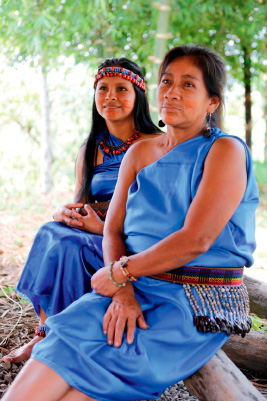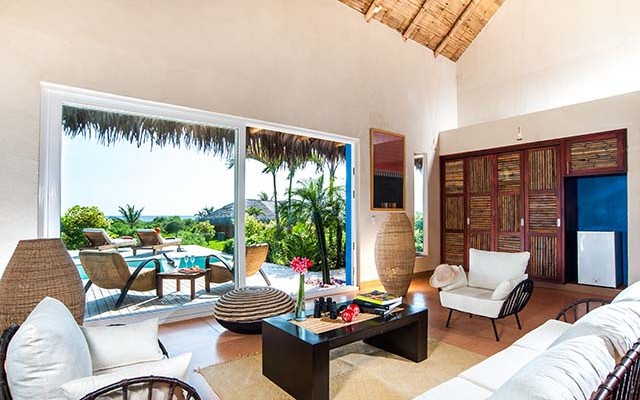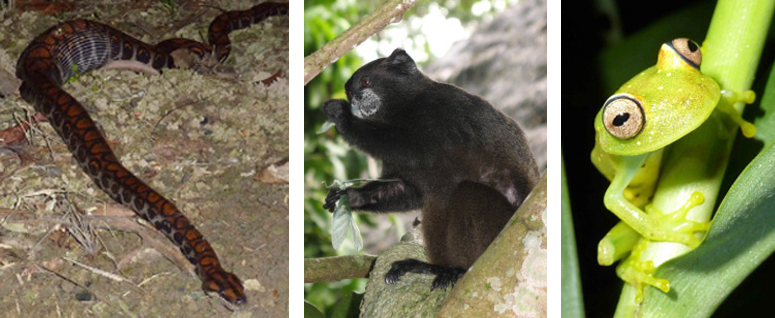The Cuyabeno Wildlife Reserve is located in Sucumbíos, one of the Amazon provinces privileged by its flora, fauna and landscapes. The Cuyabeno, a labyrinth of tropical lakes accessed only by canoe, is considered one of the most mega-diverse sites on the planet. In fact, it is located in one of Earth’s biodiversity hot-spots. It shelters 13 lakes, flooded forests and black water rivers, plus a huge concentration of vegetable and animal species.
The Reserve occupies 360,000 hectares and belongs to the National System of Protected Areas. 550 bird species inhabit the Cuyabeno, together with 350 fish species, river turtles, caimans, anacondas and more reptiles, plus 60 orchid species. It is also home of the pink dolphin, a mammal only found in lakes, rivers and fresh water courses in the Ecuadorian Amazon; lowland tapirs, coati-mundis, sahinos and deer also live here. There are more than 200 different vegetable species per hectare (12,000 flora species in all the reserve), 1,300 animal species, five ecosystems, and an impressive river network with Cuyabeno River as its backbone.
Created in July 1979, the Reserve is part of the Tri-national Program, a plan for the preservation of sustainable growth which includes protected areas in the border zones of Colombia and Peru.
It is said that paradise is in Cuyabeno. And it is true if Eden is indeed conceived as a gift from nature, a place where human beings are but one more among the hundreds of species that live in perfect harmony in a green and mega diverse kingdom.
The Teachings of the Jungle
 This is where every day is lived to its maximum and adventures roam in every corner. Visitors will not only witness biodiversity, but also have the opportunity to learn about indigenous ethnic groups living in the area. In fact, the best way to visit the Reserve is through its rivers and lakes.
This is where every day is lived to its maximum and adventures roam in every corner. Visitors will not only witness biodiversity, but also have the opportunity to learn about indigenous ethnic groups living in the area. In fact, the best way to visit the Reserve is through its rivers and lakes.
Water, land and air, all these elements are filled by new species. You will surely see the hoatzin fly while feeling as if the dinosaurs era had returned. You will observe some of the 10 monkey species registered in the Reserve jumping from tree to tree; you will find new types of orchids and discover trees with trunks of supernatural diameters. All this will surprise you in this green, damp paradise.
Another attraction is its cultural diversity: seven communities of four different ethnias have inhabited this natural sanctuary from centuries ago. Together with your guides, you will be able to come closer to some of the communities and get to know what life in the Amazon is like, learn about medicinal plants and legends, and understand why nature is so important for their people.
Arriving at the reserve means being ready to leave the city behind, together with all its hassle, vehicles, and internet connections; it means immersing in the magic of the jungle and adapting to the environment. Nevertheless, this does not mean you will forget comfort, as there are several lodges which are managed by the communities, where you will experience an authentic ecotourism adventure.
Founded in 1988, the Cuyabeno Lodge is the first one built in the Cuyabeno Wildlife Reserve. Due to the importance of preserving the surroundings, this lodge was constructed in strict abidance to environmental norms; electricity is provided by solar panels and facilities are environmentally friendly while offering comfort to its guests.
Other than this, there are at least a dozen more lodges all of them built in close communion with nature, with natural materials and a customer service provided by natives from the indigenous communities of the Amazon. In most cases men and women have been trained in guiding, hotel techniques, and languages, in order to provide customers with the best experience during their visit to the Amazon tropical forest.
The experience in the Cuyabeno Wildlife Reserve will be unforgettable; you will feel as if time stood still, and you and nature had become one.
Cuyabeno
It shelters 13 lakes, flooded forests and black water rivers. There are more than 12,000 flora species in all the reserve, 1,300 animal species, five ecosystems, and an impressive river network with Cuyabeno River as its backbone.


